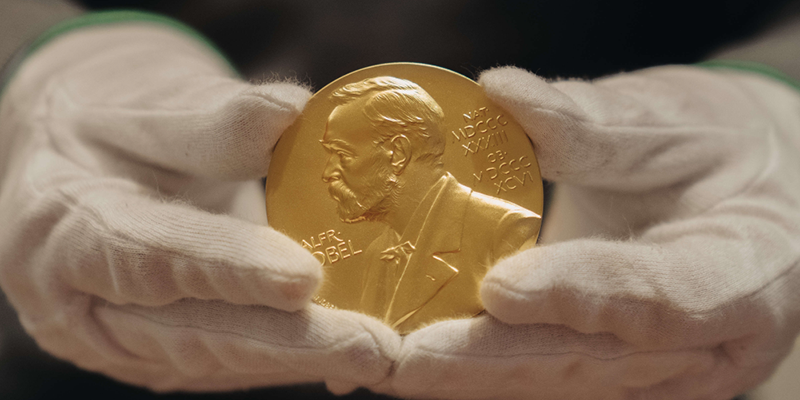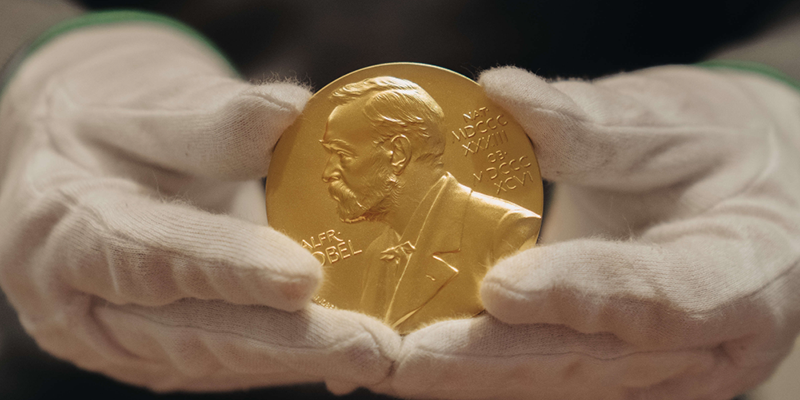Golden Ticket to Stockholm
Few would ever admit it, but some scientists dream of getting a call on an early October morning from a Scandinavian area code. Winning a Nobel Prize is never a guarantee even for highly lauded scientists, but certain huge discoveries beg for recognition. The first detection of gravitational waves in 2015 is a perfect example. The Nobel Committee didn’t wait long to honor this breakthrough with its 2017 prize in physics.
Are there any similar shoo-ins for this year’s awards being announced this week? It’s hard to say if anything stands out, but some people still try to make predictions by relying on sophisticated citation analysis, by sorting past prizes into research categories, or by turning to artificial intelligence.
Rather than speculate on this year’s prizes, Physics Magazine asked a collection of physicists to imagine future breakthroughs that—if they ever happen—will be sure to garner Nobel gold. Here’s a sampling of their responses.
“…for the direct detection of dark matter”
A bit of a no-brainer. With several experiments around the world searching for a sign of the elusive dark matter particle, it’s obvious that a successful “hit” would merit a Nobel Prize. “The dark matter problem is one of the most important in physics with many implications in its solution,” says quantum physicist Steve Girvin from Yale University. The list of dark matter candidates is long (WIMPs, axions, primordial black holes), so finally narrowing it down to one would fill in a lot of open questions in cosmology and particle physics. “I am hoping for axionic dark matter for its sheer elegance, and for the fact that we can now look for it with circuit QED techniques,” Girvin says.
Cosmology offers another Nobel-worthy target in the guise of dark energy. There are fewer candidates here, and it’s unclear what a “detection” might be, but quantum information expert Paulo Nussenzveig from the University of São Paulo puts dark energy on the top of his future Nobel list. “This is probably the biggest mystery in physics today,” he says.
“…for the demonstration of a superconductor at ambient conditions”
The 1987 Nobel Prize was awarded for the 1986 discovery of “high-temperature superconductors” that operated at −238 °C. Ever since then, physicists have been struggling to raise the superconducting temperature to a level where expensive cooling techniques would not be needed. Room-temperature superconductivity at ambient pressure is a “holy grail” that could revolutionize everything from electrical grids to computers to ground transportation. Recent progress has generated excitement, but the reality is that a Nobel for room-temperature superconductors is still a ways off.
Condensed-matter theorist Piers Coleman from Rutgers University–New Brunswick in New Jersey thinks that progress in high-temperature superconductors might come from related materials called strange metals. Strange metals have several properties that do not fit in the standard model of metals. “They are in many ways the ‘stem cells’ of novel quantum materials, and we don’t have a complete theory for their physics,” Coleman says. Finding such a strange-metal theory could unlock the puzzle of high-temperature superconductors, he says.
“…for the development of a useful quantum computer”
This potential breakthrough might suffer from an ill-defined finish line. Researchers have been claiming “quantum advantage” and other victories of quantum computers over classical computers, but there is still no consensus that quantum computing is ready to take off. What we need is “a working quantum computer that can solve real problems,” says quantum physicist Luiz Davidovich from the Federal University of Rio de Janeiro. The main hurdle to such a device is error correction. A fault-tolerant quantum computer that demonstrates a beyond-classical ability in solving meaningful problems, such as factoring large integers, would almost certainly deserve a Noble nod.
“…for the realization of topological quantum computing”
A quantum computing breakthrough might come from a radically new way to store and process data. Topological qubits offer a potentially robust option in which information would be “braided” into the quantum states of the material. No such qubits have been made yet, but researchers are exploring nanowires—which could harbor Majorana zero modes—and two-dimensional materials—which exhibit fractional quantum Hall states. Jainendra Jain, a condensed-matter scientist from Pennsylvania State University, is bullish about the latter possibility. He foresees a Nobel-worthy device that exhibits the fractional quantum Hall effect at room temperature and without an external magnetic field. By liberating this quantum behavior from magnets and refrigerators, Jain expects applications in topological computing, as well as low-loss circuits and spintronics. “This goal would have seemed like a fantasy until a few years ago, but recent developments have opened a tiny window of hope into that direction,” Jain says.
“…for delivering a sustainable energy solution to the world”
Despite recent nuclear fusion headlines, a commercial fusion power plant is likely decades away. Many challenges face both magnetic confinement and laser-based fusion techniques, but there is no shortage of enthusiasm in the guise of large-scale government-sponsored projects and small-scale start-up companies. If one of these efforts manages to continuously generate output energy above the input energy, that would be hard for the Nobel Committee to ignore, says Physical Review Letters editor Kyle Welch. “I don’t think it’s an overstatement to say that achieving scalable fusion energy production will be a turning point for humanity, especially with the ever-looming climate crisis,” he says.
Physical Review B editor Sarma Kancharla thinks that an energy revolution might come sooner from other fields. One Nobel-worthy breakthrough might be a solid-state battery technology that handily beats standard lithium batteries in energy density and charging speed. Kancharla sees another potential game changer in an inexpensive carbon-nanostructure-based solar cell with 60% energy efficiency.
“…for experimental observations that overturn the standard model”
The standard model of particle physics has passed experimental test after experimental test, but physicists know it can’t be the ultimate theory of everything. Dark matter detection (see above) would presumably be a sign of new physics beyond the standard model, but other observations might do the same. “If we are able to measure neutrinoless double beta decay, that would be a big coup,” says particle physicist Melissa Franklin from Harvard University. Such a detection would imply that neutrinos are their own antimatter particle, forcing particle physicists to rewrite their textbooks. But going beyond the standard model doesn’t require big particle detectors looking for rare events. Girvin points out that there are precision tests in atomic, molecular, and optical physics that could reveal new physics in regions of parameter space that particle accelerators can’t easily probe.
“…for providing an interpretation of quantum physics”
Quantum physics is weird, especially when considering the entanglement of widely separated pairs of particles. The 2022 Nobel Prize highlighted efforts to pierce through this weirdness with so-called Bell tests (see Nobel Prize: Quantum Entanglement Unveiled). Quantum physicist and popular science writer Chad Orzel thinks that a future Nobel pursuit would be to devise a Bell-like experiment that distinguishes between quantum interpretations, such as the “many-worlds” picture and “relational quantum mechanics.” Potential tests might involve placing a macroscopic object in a quantum superposition or measuring how fast a quantum state decoheres. “It’s a really hard problem to even conceptualize,” but Orzel thinks it would be a definite game changer in foundational physics. “It ought to earn free dinners for life, with a Nobel for dessert.”
“…for deciphering the behavior of biomolecular condensates”
There is so much going on inside a cell. The behavior of biomolecules, such as proteins, in this crowded environment is largely tied to many-body interactions—a primary focus in physics. In the past decade, physicists have helped understand small cellular structures—membraneless organelles called biomolecular condensates—which form through a type of liquid–liquid phase transition (think of oil and vinegar separating). The challenge now, says PRX Life editor Serena Bradde, is to take this a step further. “Can we understand the physical properties of these organelles as living matter and tweak them, especially when they behave anomalously?” The answer could lead to new therapeutic tools and maybe one day to a Nobel, but the prize might be in medicine or in chemistry rather than in physics.
“…for the discovery of twistronics”
Graphene has offered many surprises over the years, which is why it was the focus of the 2010 Nobel Prize in Physics. Recent work has found that two layers of graphene can change behavior (going from insulator to conductor to superconductor) just by twisting one layer with respect to the other (see Trend: Bilayer Graphene’s Wicked, Twisted Road). This discovery has already happened, but astronomer Sara Seager from the Massachusetts Institute of Technology thinks it will take time for the potential applications to materialize. Twisted bilayers might, for example, provide the substrate for other breakthroughs on this list, such as topological qubits and high-temperature superconductors. “The eventual implementation of this breakthrough makes the discovery an obvious candidate for the Nobel,” Seager says.
–Michael Schirber
Michael Schirber is a Corresponding Editor for Physics Magazine based in Lyon, France.





